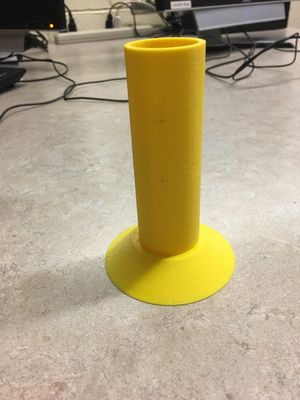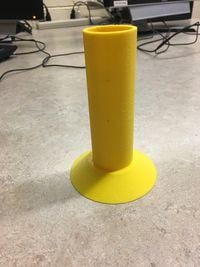Sophivorus (talk | contribs) m (Text replacement - "| affiliations = " to "| organizations = ") |
|||
| (52 intermediate revisions by 10 users not shown) | |||
| Line 1: | Line 1: | ||
{{777}} | {{777 notice}} | ||
[[File:Thermometer Jar 11cm.JPG|thumb]] | |||
{{ | |||
{{ | {{Device data | ||
{{ | | manufacturing-files = https://www.thingiverse.com/thing:1941655 | ||
}} | |||
{{Project data | |||
| authors = User:Ztverran | |||
| made = Yes | |||
| replicated = No | |||
| cost = USD 1.57 | |||
}} | |||
{{notready}} | |||
* must be printed in PP and tested in autoclave before mass use | |||
== 3D Printable Thermometer Jar for UNICEF Supply Catalogue == | |||
Project developed by [[User:Ztverran|Zachary Verran]] | |||
== Abstract == | |||
# UNICEF's supply catalogue is used to acquire commodities to respond to the needs of children and their families worldwide. In this catalogue, there is a product for use as a thermometer jar. In the catalogue, it is specified what the jar is made out of, the dimensions of the jar, and what the jar needs to be capable of. In the catalogue, it specifies that the jar needs to be made of plastic (polypropylene) and be able to be autoclavable, which means it needs to have the ability to be steam cleaned and sterilized. Following the dimension guidelines set in the catalogue, a 3D model of a jar was created using OpenScad and then printed used a RepRap Athena Delta Bot printer. The jar was printed using PLA, however the model can be printed using polypropylene filament if the proper adjustments are made to the printer and print parameters. It is thought that PLA is also capable of being a viable material for this jar, however more research in this area is needed. | # UNICEF's supply catalogue is used to acquire commodities to respond to the needs of children and their families worldwide. In this catalogue, there is a product for use as a thermometer jar. In the catalogue, it is specified what the jar is made out of, the dimensions of the jar, and what the jar needs to be capable of. In the catalogue, it specifies that the jar needs to be made of plastic (polypropylene) and be able to be autoclavable, which means it needs to have the ability to be steam cleaned and sterilized. Following the dimension guidelines set in the catalogue, a 3D model of a jar was created using OpenScad and then printed used a RepRap Athena Delta Bot printer. The jar was printed using PLA, however the model can be printed using polypropylene filament if the proper adjustments are made to the printer and print parameters. It is thought that PLA is also capable of being a viable material for this jar, however more research in this area is needed. | ||
== Bill of Materials== | [[Image:Thermometer Jar 11cm.JPG|200px|right]] | ||
== Bill of Materials == | |||
# PLA printer filament from [http://pushplastic.com/ PushPlastic] for model of product | # PLA printer filament from [http://pushplastic.com/ PushPlastic] for model of product | ||
# OR Polypropylene printer filament found at [ | # OR Polypropylene printer filament found at [https://web.archive.org/web/20210617213737/https://gizmodorks.com/polypropylene-3d-printer-filament/ GIZMODORKS PP Printer Filament] | ||
## [http://www.thingiverse.com/thing:1941655 Files on Thingiverse Page] | ## [http://www.thingiverse.com/thing:1941655 Files on Thingiverse Page] | ||
== Tools needed | == Tools needed == | ||
# [[Athena Build Overview| MOST Delta RepRap]] or similar RepRap 3-D printer | |||
# [[Athena Build Overview|MOST Delta RepRap]] or similar RepRap 3-D printer | |||
== Skills and | == Skills and knowledge needed == | ||
*Knowledge of 3D printing as taught by the [[MY4777|MY477 Class]] at Michigan Technological University. | |||
* Knowledge of 3D printing as taught by the [[MY4777|MY477 Class]] at Michigan Technological University. | |||
== Technical Specifications and Assembly Instructions == | |||
* No assembly necessary for this device, simply print the part using the desired infill. | * No assembly necessary for this device, simply print the part using the desired infill. | ||
* The infill used for the most recent prototype was 15%, however more research can be done to optimize the infill percentage for the given use. | * The infill used for the most recent prototype was 15%, however more research can be done to optimize the infill percentage for the given use. | ||
| Line 29: | Line 49: | ||
** Layer height: 0.20 | ** Layer height: 0.20 | ||
** Shell, bottom and top layer thickness: 1.0 | ** Shell, bottom and top layer thickness: 1.0 | ||
* Technical Specifications: | * Technical Specifications: | ||
** Material: Polypropylene, autoclavable. | ** Material: Polypropylene, autoclavable. | ||
| Line 37: | Line 55: | ||
** Overall height: approximately 120mm. | ** Overall height: approximately 120mm. | ||
=== Common Problems and Solutions=== | === Common Problems and Solutions === | ||
* No assembly necessary, only problems with device is printer issues, which can be solved using the Most Delta Google group for example. | * No assembly necessary, only problems with device is printer issues, which can be solved using the Most Delta Google group for example. | ||
== Cost== | == Cost == | ||
*Cost of print based on material usage and $30/kg for filament: | |||
* Cost of print based on material usage and $30/kg for filament: | |||
** $1.57 | ** $1.57 | ||
==References== | == References == | ||
*web page: "Jar,thermometer,pp,11cm,w/o Cover." Supply Catalogue. UNICEF Web. Available: [https://supply.unicef.org/unicef_b2c/app/displayApp/(cpgsize=5&layout=7.0-12_1_66_69_115_2&uiarea=2&carea=4FB33C8B49B94843E10000009E710FC1&cpgnum=2&citem=4FB33C8B49B94843E10000009E710FC14EBA1106BBC20F68E10000009E71143E)/.do?rf=y | UNICEF Supply Catalogue] | * web page: "Jar,thermometer,pp,11cm,w/o Cover." Supply Catalogue. UNICEF Web. Available: [https://supply.unicef.org/unicef_b2c/app/displayApp/(cpgsize=5&layout=7.0-12_1_66_69_115_2&uiarea=2&carea=4FB33C8B49B94843E10000009E710FC1&cpgnum=2&citem=4FB33C8B49B94843E10000009E710FC14EBA1106BBC20F68E10000009E71143E)/.do?rf=y | UNICEF Supply Catalogue] | ||
<references/ | <references /> | ||
. | |||
{{Page data | |||
| keywords = 3D printing, UNICEF, thermometer jar | |||
| sdg = SDG03 Good health and well-being, SDG08 Decent work and economic growth | |||
| organizations = Michigan_Tech's_Open_Sustainability_Technology_Lab | |||
| license = CC-BY-SA-3.0 | |||
| language = en | |||
}} | |||
[[Category:How tos]] | [[Category:How tos]] | ||
[[Category:Health]] | [[Category:Health]] | ||
[[Category:Clinical safety]] | [[Category:Clinical safety]] | ||
[[Category:OSAT 3D-Printable Designs]] | |||
[[Category:3D printing]] | |||
[[ | |||
Latest revision as of 15:07, 28 February 2024

- must be printed in PP and tested in autoclave before mass use
3D Printable Thermometer Jar for UNICEF Supply Catalogue[edit | edit source]
Project developed by Zachary Verran
Abstract[edit | edit source]
- UNICEF's supply catalogue is used to acquire commodities to respond to the needs of children and their families worldwide. In this catalogue, there is a product for use as a thermometer jar. In the catalogue, it is specified what the jar is made out of, the dimensions of the jar, and what the jar needs to be capable of. In the catalogue, it specifies that the jar needs to be made of plastic (polypropylene) and be able to be autoclavable, which means it needs to have the ability to be steam cleaned and sterilized. Following the dimension guidelines set in the catalogue, a 3D model of a jar was created using OpenScad and then printed used a RepRap Athena Delta Bot printer. The jar was printed using PLA, however the model can be printed using polypropylene filament if the proper adjustments are made to the printer and print parameters. It is thought that PLA is also capable of being a viable material for this jar, however more research in this area is needed.

Bill of Materials[edit | edit source]
- PLA printer filament from PushPlastic for model of product
- OR Polypropylene printer filament found at GIZMODORKS PP Printer Filament
Tools needed[edit | edit source]
- MOST Delta RepRap or similar RepRap 3-D printer
Skills and knowledge needed[edit | edit source]
- Knowledge of 3D printing as taught by the MY477 Class at Michigan Technological University.
Technical Specifications and Assembly Instructions[edit | edit source]
- No assembly necessary for this device, simply print the part using the desired infill.
- The infill used for the most recent prototype was 15%, however more research can be done to optimize the infill percentage for the given use.
- With 15% infill, estimated print time is 3 hours and 45 minutes with a print speed of 50mm/s.
- Layer height: 0.20
- Shell, bottom and top layer thickness: 1.0
- Technical Specifications:
- Material: Polypropylene, autoclavable.
- Internal diameter: approximately 30mm.
- Depth: approximately 110mm.
- Overall height: approximately 120mm.
Common Problems and Solutions[edit | edit source]
- No assembly necessary, only problems with device is printer issues, which can be solved using the Most Delta Google group for example.
Cost[edit | edit source]
- Cost of print based on material usage and $30/kg for filament:
- $1.57
References[edit | edit source]
- web page: "Jar,thermometer,pp,11cm,w/o Cover." Supply Catalogue. UNICEF Web. Available: | UNICEF Supply Catalogue
.